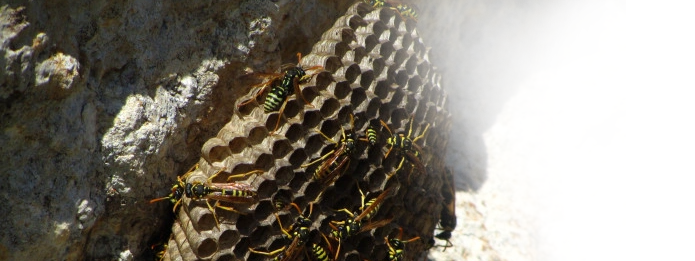
As winter approaches Ontario, the local insect population prepares for the cold weather by either hibernating or leaving summer nests to live out the remainder of their life cycle. You might notice that wasps are especially active in the fall as the last of the warm weather holds out, but what happens when winter arrives? How does cold weather affect them? Our services for wasp control in Kitchener can help you understand this insect’s behaviour and protect your property for the following spring by providing you with a few tips for keeping them away.
A Social Insect
Wasps live in social groups that are designed to serve one fertile female known as the queen. Each spring, a queen comes out of hibernation and chooses a place to construct a new nest. She builds a few chambers and lays some eggs, and over the course of the spring and summer, those larvae hatch and grow into adults, with the job of caring for the future eggs. Several unmated females are typically born to this hive and will one day leave to build new colonies of their own as future queens.
As fall arrives, the last of that year’s larvae grow to maturity, and most occupants leave to forage for food on their own. In most cases, all but the young queens die off as the cold weather comes. When temperatures drop and the season’s first frost arrives, most wasps can no longer fly and die from the cold. By the end of the fall, the nest is usually abandoned. If you happen to come across a wasp nest after the first frost, you can call our team for wasp control in Kitchener to ensure its safe removal, as a few stragglers might remain inside.
A Queen in Winter
Once all the male workers and infertile wasps leave the nest in fall, they only have a few more weeks of life left and soon die off, along with that year’s queen. New queens born that year find a warm, dry place to hibernate, such as inside the trunk of an old tree, under a large rock or inside your garage or shed. The insects sleep away the winter and enter a torpor that does not require them to eat.
Young queens can be hard to spot in the winter, especially when they hide in the crevices around the exterior of your home. Truly Nolen can help you prevent the spread of wasps when spring comes by treating common hibernation spots. The more young queens are eliminated at this time, the lesser the risk of new nests in the spring. If you happen to see a wasp in your shed or garage during the cold weather, it is likely a queen looking for a place to hibernate.
Abandoning Old Nests
When winter comes and a wasp’s nest empties, it is not utilized by new queens the following year. However, though no individual wasps will return to this nest before the end of the year, as males usually die-off from cold temperatures or from starvation, you may want to have our team come out and remove old nests as a precaution.
The cold season is usually the safest time of year to dispose of old nests and clean out any clutter so a new queen does not make use of the area the following year. Wasps often build nests on the corners of buildings, under eaves and even in piles of unused wood.
Winter means the end of a life cycle for many wasps, but queens await to bring forth the next generation once spring arrives. Call us today for wasp control and gain peace of mind that your property remains free of these problematic insects.